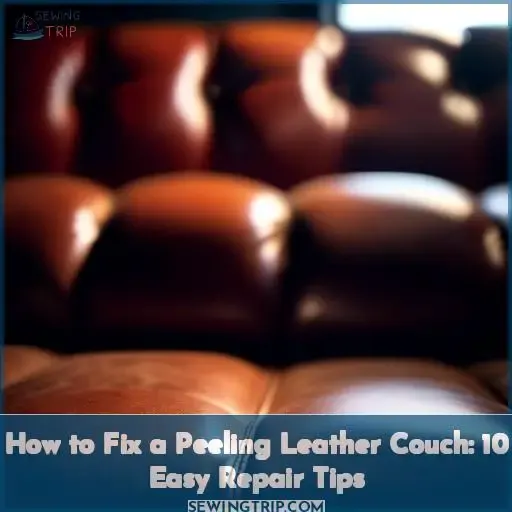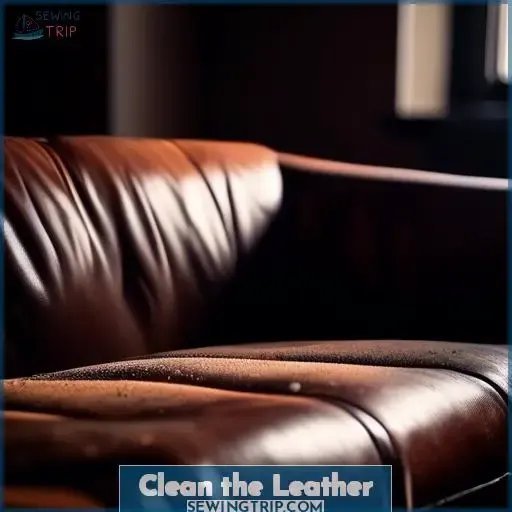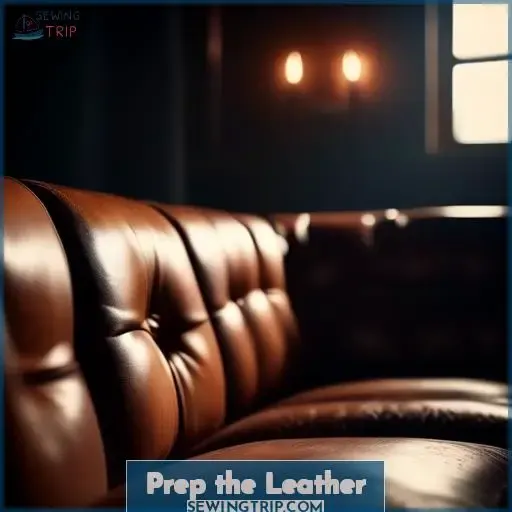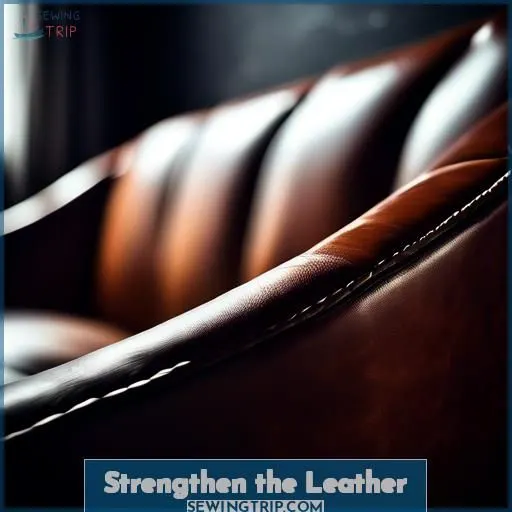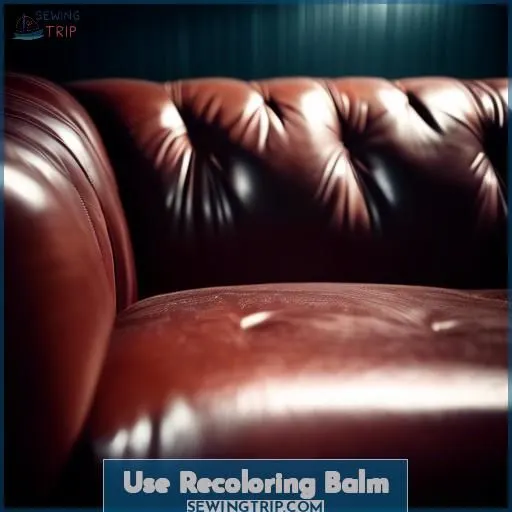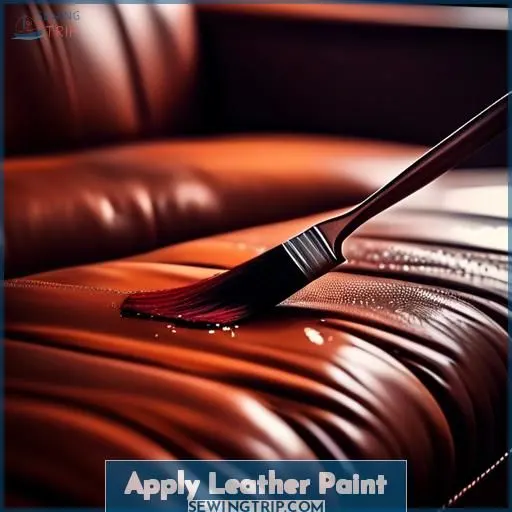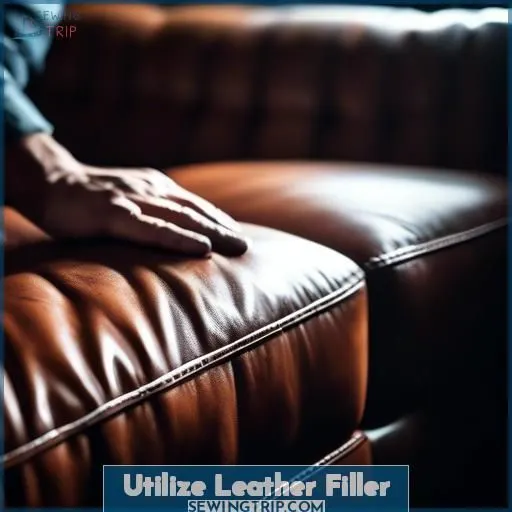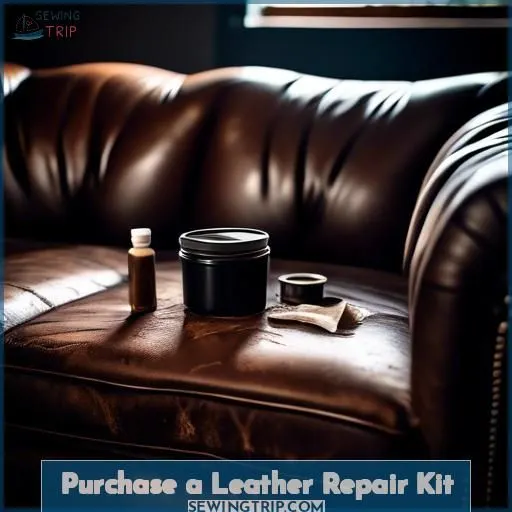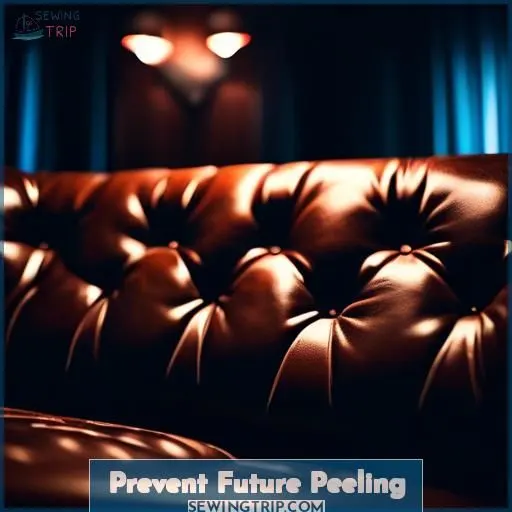This site is supported by our readers. We may earn a commission, at no cost to you, if you purchase through links.
To fix a peeling leather couch, start by identifying the cause of the peeling**. This could be due to moisture deficiency, heat and sunlight exposure, improper cleaning and maintenance, age, or wear and tear.
Once you’ve determined the cause, clean the leather using a vacuum, gentle cleaning, and leather conditioner. Then, prep the leather by determining its type, applying olive oil, and using recoloring balm or leather paint.
Strengthen the leather by inspecting material compatibility, evaluating the connection between the leather and its finish, and initiating the repair process. To prevent future peeling, monitor humidity levels, shield from sun damage, and refine cleaning methods.
If necessary, use a leather repair kit, leather binder, or leather filler.
Table Of Contents
- Key Takeaways
- How to Fix a Peeling Leather Couch?
- Identify the Cause of Peeling
- Clean the Leather
- Prep the Leather
- Strengthen the Leather
- Use Recoloring Balm
- Apply Leather Paint
- Utilize Leather Filler
- Purchase a Leather Repair Kit
- Apply a Leather Binder
- Prevent Future Peeling
- Frequently Asked Questions (FAQs)
- Conclusion
Key Takeaways
- Identify the cause of peeling leather, which could be due to moisture deficiency, heat and sunlight exposure, improper cleaning and maintenance, age, or wear and tear.
- Clean the leather using a vacuum, gentle cleaning, and leather conditioner. Prepare the leather by determining its type, applying olive oil, and using recoloring balm or leather paint.
- Strengthen the leather by inspecting material compatibility, evaluating the connection between the leather and its finish, and initiating the repair process.
- Prevent future peeling by monitoring humidity levels, shielding from sun damage, and refining cleaning methods. If necessary, use a leather repair kit, leather binder, or leather filler.
How to Fix a Peeling Leather Couch?
To fix a peeling leather couch, you can use leather paint, leather binder, or leather filler. First, prepare your couch by vacuuming it and wiping the area with alcohol. Then, apply leather paint with a paintbrush, leather binder to strengthen the material, or leather filler for more labor-intensive repairs. After completing the repairs, apply a leather binder to prevent future problems. Remember to protect your leather couch from low humidity and sun damage to prevent peeling and cracking.
Identify the Cause of Peeling
Leather peeling can be a frustrating issue, but understanding its causes can help you prevent and repair it effectively. The primary cause of peeling is moisture deficiency, which can lead to the finish or paint on your leather furniture cracking or delaminating. Other factors, such as heat and sunlight exposure, improper cleaning and maintenance, age, and wear and tear, can also contribute to peeling.
To prevent peeling, make sure your leather stays moisturized, avoid direct sunlight, and maintain regular cleaning and conditioning. If peeling occurs, consider using a leather repair kit, leather filler, or leather binder to strengthen the material before applying a recoloring balm, leather paint, or leather paint for larger areas. Remember to test remedies on an inconspicuous area first and use a soft cloth or sponge to apply them.
If the peeling is severe, consider professional repair or reupholstery.
Clean the Leather
To clean a leather couch and keep it looking its best, follow these steps:
- Vacuum the Couch: Use a soft-bristled vacuum attachment to remove any loose dirt, dust, and debris from the sofa’s surfaces and crevices.
- Test the Cleaner: Before applying any cleaning solution, test it on an inconspicuous area of the leather to guarantee it doesn’t damage the finish or discolor the material.
- Gently Clean the Leather: Use a soft cloth or sponge dipped in a mixture of a mild cleaner, such as a prepping solution or a gentle detergent, and water. Avoid using abrasive materials or harsh chemicals that can damage the leather.
- Apply Leather Conditioner: After cleaning, apply a leather conditioner to maintain the leather’s moisture and suppleness.
- Allow it to Dry: Allow the leather to air dry naturally to prevent damage from heat or artificial drying methods.
Remember to always test any cleaning solution on a small, inconspicuous area of the leather before applying it to the entire couch. This will help prevent any potential damage to the finish or color of the leather.
Prep the Leather
Now that you’ve cleaned your leather couch, it’s time to prep it for repair. First, you need to understand the type of leather you’re dealing with. If it’s real leather, you’ll want to choose a cleaner that’s appropriate for the type, such as a vinegar solution for aniline leather or a baking soda paste for nubuck. For faux leather, a mild soap solution should suffice.
Once the leather is clean, you can apply olive oil to help maintain its moisture and suppleness. If the peeling is minor, you can use a recoloring balm or leather paint to touch up small areas. But remember, if the peeling is severe, it might be time to contemplate professional repair or reupholstery.
In the meantime, make sure to condition the leather regularly to prevent future peeling.
Strengthen the Leather
To bolster your leather couch’s resilience, it’s vital to evaluate the connection between the leather and its finish. Start by inspecting the material compatibility and adhesion assessment. Factor in the leather’s durability testing, ensuring its ability to cope with the rigors of daily use.
Once you’ve established the leather’s strength, you can initiate the repair process. Remember, a solid foundation is paramount for a successful repair.
Use Recoloring Balm
To use recoloring balm on your peeling leather couch, follow these steps:
- Choose a balm that matches the color of your leather couch.
- Apply the balm to the peeling areas using a soft cloth or sponge.
- Allow the balm to dry completely before touching or using the couch.
- Check the balm’s durability and make sure it’s suitable for your specific leather type.
- Balm is available at most home improvement stores or online.
Apply Leather Paint
After rejuvenating your leather couch with recoloring balm, it’s time to tackle larger blemishes with leather paint. Color matching is key to a seamless mend. Use a roller for an even application, ensuring no spot feels left out. Respect those drying times – rushing may lead to a tacky situation, both literally and figuratively. For tiny imperfections that pop up, a quick touch-up will do the trick. Keep your couch’s color looking sharp, and it’ll repay you with years of loyal service.
Utilize Leather Filler
Regarding repairing peeling leather, leather filler is another efficacious option. This filler is commonly crafted from a margarine-esque substance capable of being applied to the blemished areas to reinstate the leather’s aesthetic appeal. To leverage leather filler, you must select an appropriate tool. A diminutive spatula or putty knife is frequently the optimal choice, as it facilitates the uniform and judicious application of the filler.
Upon selecting your tool, it’s time to apply the filler. Commence by cleansing the area you intend to fill using a cloth and a gentle soap solution. Permit the area to desiccate entirely prior to applying the filler. Once dry, employ your tool to apply the filler to the damaged area, smoothing it out as you proceed. Ensure that you work with alacrity, as the filler may commence solidifying before you have concluded.
After applying the filler, permit it to cure for at least 24 hours before manipulating it. This cure time is imperative, as it allows the filler to fully solidify and adhere to the leather. Moreover, bear in mind that the filler may not congruously match the hue of your leather, thereby necessitating that you test it on an inconspicuous area initially.
Purchase a Leather Repair Kit
Purchasing a leather repair kit can be a cost-efficient and DIY-friendly solution for fixing peeling leather. These kits often come with a range of products that cater to various repair needs. Here are four key components typically found in a leather repair kit:
- Leather Dye Colorant: This is used to recolor the leather, ensuring a seamless repair.
- Leather Color Prep & Cleaner: This solution prepares the leather surface for the dye, ensuring better adhesion.
- Leather Protection Cream: This cream helps safeguard the repaired area from future damage.
- Leather Adhesive: Used to bond the repaired area to the rest of the leather.
These kits are designed to make the repair process easy and efficient, often including application tools and a detailed instruction booklet. They can be particularly useful for small to medium-sized repairs, where color matching is required. However, for larger repairs or more complex damage, professional repair might be more suitable.
When exploring a leather repair kit, it’s vital to mull over the longevity of the repair and the compatibility of the products with your leather type. High-quality kits should offer a wide range of colorants and strong, durable adhesives suitable for various leather types and damages. Always test the products on an inconspicuous area before applying them to the damaged leather.
Apply a Leather Binder
Applying a leather binder is a critical step in repairing a peeling leather couch, as explained in this article. A leather binder fortifies the material, enabling it to withstand future wear and tear. There are various types of leather binders available, including heat-sealed, turned and sewn, and vinyl binders. When selecting a leather binder, consider the type of leather you have, as some binders may be more appropriate for certain leather types.
To apply a leather binder, follow these steps:
- Prepare the leather: Clean the leather surface with a prepping solution and alcohol to remove any dirt or debris.
- Apply the binder: Use a sponge or brush to apply the binder onto the leather surface, guaranteeing even coverage.
- Allow drying: Allow the binder to dry naturally or use a hairdryer to speed up the process.
Drying times for leather binders can vary, with some drying within minutes when applied thinly, while others may take longer when applied thicker. Always follow the manufacturer’s instructions for the specific binder you’re using.
When choosing a leather binder, consider the brand and its reputation for quality and durability. Some popular brands include LeTech International Ltd (UK) and Forbes Custom Products, which offer a range of leather binders suitable for various leather types and applications.
Remember to test the binder on an inconspicuous area first to ensure it doesn’t discolor or damage the leather. Always use a soft cloth or sponge to apply the binder, and avoid using excessive force or heat, as this can damage the leather.
Prevent Future Peeling
To keep your leather couch from peeling again, think of it like skin that needs hydration and protection. Here’s your battle plan:
- Monitor humidity levels: Just like your skin in dry weather, leather craves moisture. Aim for that sweet spot in humidity to keep it supple.
- Shield from sun damage: Your couch is no sunbather. Position it away from harsh rays to prevent a leather sunburn.
- Dial in conditioning frequency: Regular spa days with a quality conditioner will keep the leather young and flexible.
- Refine cleaning methods: Gentle is the name of the game. Use a soft touch and mild cleaners to pamper your couch.
- Invest in leather quality: Skimping on leather is like buying cheap shoes – they won’t last. Splurge a little for long-term happiness.
Frequently Asked Questions (FAQs)
Can peeling leather couches cause allergic reactions?
Peeling leather couches can cause allergic reactions in some individuals. These reactions are often due to the presence of anti-fungal and antimicrobial agents, such as dimethyl fumarate (DMF), used in the leather tanning process.
If you suspect an allergic reaction, it’s essential to consult a dermatologist or allergist for proper diagnosis and treatment, which may include topical and/or oral steroids and emollients.
To minimize the risk of allergic reactions, consider purchasing furniture made from hypoallergenic materials like organic cotton or wool, or opt for leather-free alternatives.
How does weather affect leather couch maintenance?
Winter weather can notably impact the upkeep of a leather couch. Cold temperatures can make leather dry and inflexible, increasing its susceptibility to cracks and wrinkles. Moreover, low moisture levels in the surrounding air can worsen these problems, as leather requires hydration to maintain its suppleness and elasticity.
To protect your leather couch during winter, keep it away from direct heat sources, such as radiators and vents, and position it in the center of the room where dry heat can’t directly affect it. Regular cleaning with a non-abrasive cleaning solution and conditioning with a specialized leather conditioner once or twice a year can also help maintain the integrity of the leather and minimize damage caused by the dry winter air.
Are there eco-friendly alternatives to leather repair kits?
Yes, you can opt for eco-friendly leather repair alternatives like using a balm made from natural oils or a DIY mix of vinegar and olive oil to rejuvenate and repair your couch’s peeling areas.
How long does a repaired leather couch last?
Imagine your leather couch as a seasoned traveler, its repairs like passport stamps. With diligent care, it can embrace comfort for years, but neglect could see it retire sooner than a decade.
Can peeling leather be prevented in high humidity areas?
Peeling leather can be prevented in high humidity areas by maintaining adequate humidity levels to prevent leather dryness. This can be achieved by using a humidifier or placing a bowl of water near the leather couch.
Conclusion
If your leather couch is peeling, don’t throw it away just yet! With a few simple steps, you can easily fix it and make it look as good as new.
Start by identifying the cause of the peeling. This could be due to factors like excessive sun exposure, improper cleaning, or natural wear and tear over time.
Next, clean and prep the leather. Use a mild leather cleaner and a soft cloth to gently remove any dirt or debris. This will help the repair process.
Strengthen the leather by inspecting material compatibility and repairing any damage. If the peeling is severe, you may need to use a leather filler or binder to reinforce the material.
Use a recoloring balm or leather paint to restore the original color and finish of the couch. Apply it evenly and allow it to dry completely.
Finally, protect the leather by monitoring humidity levels and shielding it from direct sunlight. This will help prevent future peeling and extend the life of your couch.
By following these tips, you’ll be able to fix your peeling leather couch and enjoy it for years to come.

